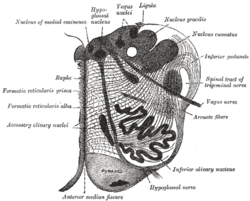- Nucleus raphe magnus
-
Brain: Nucleus raphe magnus 
Section of the medulla oblongata at about the middle of the olive. (Raphe nuclei not labeled, but 'raphe' labeled at left.) Latin nucleus raphes magnus NeuroNames hier-736 NeuroLex ID birnlex_1363 The nucleus raphes magnus, located directly rostral to the nucleus raphes obscurus, is afferently stimulated from axons in the spinal cord and cerebellum.
This makes the nucleus raphes magnus a likely candidate for part of the motor system; however, it seems to participate in the endogenous analgesia system. Mounting evidence suggests that the nucleus raphes magnus plays an important role in homeostatic regulation [1][2].
The nucleus raphes magnus receives descending afferents from the periaqueductal gray, the paraventricular hypothalamic nucleus, central nucleus of the amygdala, lateral hypothalamic area, parvocellular reticular nucleus and the prelimbic, infralimbic, medial and lateral precentral cortices [3].
All of these brain areas influence the main function of the nucleus raphes magnus.
The main function of the nucleus raphes magnus is mostly pain mediation; in fact it sends projections to the dorsal horn of the spinal cord to directly inhibit pain. The nucleus raphes magnus releases enkephalin when stimulated.
The periaqueductal gray, the epicenter of analgesia, sends efferent connections to the nucleus raphes magnus in when it is stimulated by opiates (endogenous or otherwise).
Electrical stimulation of the PAG produces analgesia, as well as administration of morphine to the PAG or nucleus raphes magnus.
The antinociceptic effects of electrical stimulation of the PAG can be blocked by administering naloxone, an opiate antagonist, to the nucleus raphes magnus.
All of this seems to indicate that the nucleus raphes magnus is part of the endogenous opiate system, and acts to inhibit pain in the spinal cord.
See also
References
- ^ Hellman, Kevin et al. Activity of murine magnus raphe cells predicts tachypnea and on-going nociceptive responsiveness. Journal of Neurophysiology Volume 98, Issue 6, December 2007, Pages 3121-33.
- ^ Hellman, Kevin et al., Opioid microinjection into raphe magnus modulates cardiorespiratory function in mice and rats. American Journal of Physiology Regulator Integratory Comp Physiology. Volume 297, Issue 5, November 2009, Pages R1400-8.
- ^ Hermann, Dirk M. et al. Afferent projections to the rat nuclei raphes magnus, raphes pallidus and reticularis gigantocellularis pars demonstrated by iontophoretic application of choleratoxin (subunit b). Journal of Chemical Neuroanatomy Volume 13, Issue 1 , June 1997, Pages 1-21
Human brain: rhombencephalon, myelencephalon: medulla (TA A14.1.04, GA 9.767) Dorsal SurfacePosterior median sulcus · Posterolateral sulcus · Area postrema · Vagal trigone · Hypoglossal trigone · Medial eminenceafferent: GVA: VII,IX,X: Solitary/tract/Dorsal respiratory group · SVA: Gustatory nucleus · GSA: VIII-v (Lateral, Medial, Inferior)
efferent: GSE: XII · GVE: IX,X,XI: Ambiguus · SVE: X: Dorsal · IX: Inferior salivatory nucleusVentral Ventral respiratory group · Arcuate nucleus of medulla · Inferior olivary nucleus · Rostral ventromedial medullaSurfaceGrey: Raphe/
reticularReticular formation (Gigantocellular, Parvocellular, Ventral, Lateral, Paramedian) · Raphe nuclei (Obscurus, Magnus, Pallidus)Categories:
Wikimedia Foundation. 2010.
